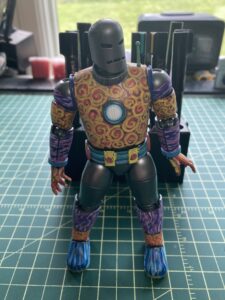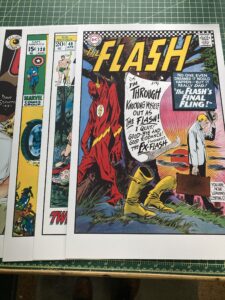Sometimes my brain is tired and just can’t handle making any art but my hands still want to do something. It’s kind of a weird situation that most people never face but it’s fairly common to me. At those times I’ll do some things that are closer to craft than to art.
The difference between art and craft is the difference between creation and recreation. Keep in mind that there is a lot of overlap between the two. Art only has to be made once. Craft is making something many times over. If I’m making a painting I don’t ever think about painting that exact same painting again. If I’m knitting a sweater I want to make a pattern for that sweater so I can make more of them. It’s a different thought process knowing you have to make more than one of something.
The two crafts that I was making were making prints form the covers of old comic books and painting an action figure.
Let’s take painting the action figure first. It’s an action figure of the original iron Man in his grey armor. I bought this one specifically because it is all grey and I thought it would be fun to paint. I’m going to paint him over time and so far I’ve only painted his arms.
This one has a lot of overlap between art and craft. It’s like painting a model and there are a lot of people who paint models and it’s mostly craft. They have learned a lot of techniques to paint models realistically and they do a terrific job of it because they know exactly what they’re doing. If they want to paint shiny armor they know the steps and can follow them precisely. That’s not what I’m doing.
I’m painting the toy in a more artsy way. I’m making Iron Man look like an abstract expressionist toy. So far one part of his arm is painted with swirls and the other with off color tiger stripes. I’m using acrylic paint pens and I have to invent my technique as I go.
The inventing of the technique is the artistic part. It’s like the person who comes up with the pattern for the sweater. That’s where the art is. Once the sweater pattern is done then anyone with knitting skills can recreate that pattern with their crafting skills. Anyone who learns these painting techniques that I’m coming up with (it’s not hard) can paint an Iron Man toy like mine. That’s the craft of it all.
The second thing I was doing is 100% craft. First of all let’s start off with the fact that I own an inkjet printer and if you own an inkjet printer you have to use it. If you don’t use an inkjet printer often its print heads will clog up and you have to waste ink running cleaning cycles. Is I like to print with mine at least a few time a week.
As you can tell from this blog I’m a comic book fan. One of the things I like to print out are 11×17 inch versions of comic book covers that I like. Just last week I bought a copy of The Flash #159 with a cover by Carmine Infantino with the intent of making myself a print of it. Just for fun. I looked on eBay for a copy of it that had a good clean cover, that means less digital clean up work for me, and I found one for about $20. Nice.
The process of making a print of the cover is all craft. Anyone can do it. At least anyone with a scanner and copy of Photoshop or the equivalent. I’ve been working digitally for thirty years so coming up with the technique for this was easy for me and it’s probably the same technique that anyone with digital skill would come up with.
First I scan in the comic book cover at 600 DPI. That’s as high a resolution as my scanner can do and it’ll be plenty. That’s my master file and I open it up to work on. The first thing that I do is to copy the image of the cover onto a new layer. I’ll make changes on this new layer/copy and leave the original untouched in case I have to go back to it.
After making sure the image is straight It’s mostly a matter of using the healing brush and clone tool to clean up any imperfections in the scanned art. Since the Flash comic is from the 1960s there are some nicks, scrapes, and ticks in the original ink. It takes some time and a sharp eye but these can be clean up fairly easily. I’ve also discovered over the years that “Content Aware Fill” does a good job of duplicating the line screen that comics are printed with. It duplicates the comic book dots well. That can help.
Then I open up my 11×17 inch digital template (it’s at 300 dpi for printing) and paste in the new cleaned up comic book cover image. I have a black border in the template to cover up the ragged edges of an old comic book. At this point I will also clean up the edges to make sure they meet the border nicely.
I also have to color correct the comic. I convert the color to CMYK (Cyan, Magenta, Yellow and Black each color has its own “Channel”) from RGB (Red, Green, Blue) because the original comic was printed using the CMYK color space and I find it easier to color correct in CMYK. I’ve found that with these old comics the color had faded a little and also yellowed.
I use an adjustment layer and adjust the “Curves.” The curves are just a visual representation of what color is in the piece. I can adjust the curve of each individual channel. First I adjust the bottom of the curve. I move 10% down to 0%. That means that anything that was 10% of a color is now white. That gets rid of the paper greying over time. But the paper is still more yellow than any other color so I open the yellow channel and turn that down 20% to 0% and the “Paper” is white again.
Then I have to strengthen the top of the color curves. The original comic was printed only with 100% black ink but as I look in the black channel it’s much less than 100%. So I turn 60% black all the way up to 100% and the black channel is strong again.
Here is where knowledge of old school comic book coloring comes in handy. I know that the Flash’s costume is 100%M with 100%Y. My scan only has them at about 80%. So I go into the channels and turn them up. The same for blue.
Now that all the color correcting is done I print it out. Getting all the print settings correct is its own chore. If any of them are wrong the print comes out wrong. So I pick matte paper, the matte paper setting, 11×17 inch size, high quality printing, Photoshop manages color, hard proofing, and CMYK color space. I find that this gives me the best color. Then I print it out and have it to look at.
There you go. That is the couple of things that I was doing yesterday when I didn’t have the energy to make art. Sure craft takes energy too but it’s a different kind of energy. At least I had that kind.

